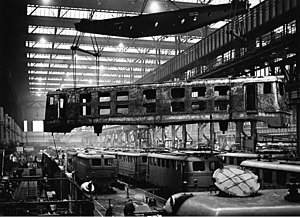SŽD series К
| SŽD series К | |
|---|---|
|
Shell construction of a K at Krupp
|
|
| Numbering: | K.01 - 20 |
| Number: | 20th |
| Manufacturer: | el. SSW mech. Croup |
| Year of construction (s): | 1961–1962 |
| Retirement: | 1978 |
| Axis formula : | Co'Co ' |
| Gauge : | 1520 mm |
| Length over coupling: | 21,000 mm |
| Service mass: | 138 t |
| Friction mass: | 138 t |
| Wheel set mass : | 23 t |
| Top speed: | 100 km / h |
| Hourly output : | 4,950 kW |
| Continuous output : | 3,350 kW |
| Wheel diameter: | 1,250 mm |
| Power system : | 25 kV with 50 Hz ~ |
| Power transmission: | Overhead line |
| Number of traction motors: | 6th |
| Drive: | Pawbearing drive |
| Brake: |
Pneumatic brake Resistance brake |
| Control: | High voltage power transmission |
| Coupling type: | SA-3 (central buffer coupling) |
| Particularities: | one of the first SŽD locomotives with converters and rectifiers made from semiconductor technology |
The SŽD series K is an SŽD locomotive designed for alternating voltage with 25 kV and 50 Hz for freight traffic . The abbreviation K stands for the initials of К ремний Диод ( silicon diodes ). They were delivered from the German plants SSW and Krupp from 1961 to 1962 . They are one of the first SŽD electric locomotives with a static converter made from semiconductor technology . The locomotives retired from active service in 1978 and no locomotive has survived.
history
At the end of the 1950s, the electric locomotive factory Novotscherkassk delivered the electric locomotives of the ВЛ60 series, which had a rectifier unit made of ignitrones . Although AC electric locomotives were indisputably superior to DC electric locomotives, they had a number of deficiencies. This particularly concerned the large dimensions of the ignitrones and their cooling with cooling liquid. The advantage of devices made of semiconductor technology , especially the rectifier based on silicon, was all the more obvious . These devices could work in a much wider range of temperatures and had a much greater degree of efficiency, so that the application of cooling with air resulted in them.
That is why the Ministry of Transport and Communications placed an order in 1959 for the design of a six-axle locomotive of the ВЛ62 series . At the same time, in order to gain experience, 20 six-axle locomotives for AC voltage and with static converters made of semiconductors were ordered from the West German companies SSW and Krupp. The first locomotive was manufactured in March 1961, it was given the designation K-01 and was tested on a section in the Saarland . The locomotive received a provisional pulling and buffing device for the inspection . As a result, the capacity of the locomotive could not be fully exploited, and the inspection was carried out with a train weighing only 2,000 t. The check was carried out with only three connected traction motors on one bogie, the other bogie also ran as a running bogie. From the second half of 1961, the K series electric locomotives came to the USSR . They were checked in August that year on the Oscherelje - Pavelets section of the Moskovskaya zheleznaja doroga . After construction, the K-02 locomotive was sent to the track ring of the All-Russian Research Institute for Rail Transport for power and energy testing. This test determined a coefficient of performance of 0.86 and an overall efficiency of 0.83 for the locomotive. Their force-performance characteristics were also created.
In 1962, all electric locomotives of the K series were given to the Kawkasskaya depot of the Severo-Kawkasskaya seleznaja doroga for regular operation . They were mainly operated on the Bataisk - Kawkasskaya section. The main disadvantage of the locomotives was the inadequate commutation of the electric motors of the auxiliary machines, which led to strong spark formation and thus to contamination of the machine room. The locomotives were not in operation for long because spare parts were not procured and maintenance was not carried out. At the beginning of 1976 there were only seven machines left in the Kawkasskaya depot, and by the end of the same year there were only five operational locomotives (numbers 2, 9, 11, 13 and 17). The locomotive with inventory number 4 was given to the Novocherkassk electric locomotive factory. In 1978, all of the K series electric locomotives that were still in existence were shut down and soon afterwards were retired.
See also
literature
- Vitaly Alexandrovich Rakov: Lokomotivy otetschestvennych zhelesnych dorog. 1956–1975 gg . Transport, Moskva 1999, ISBN 5-277-02012-8 (Russian).
